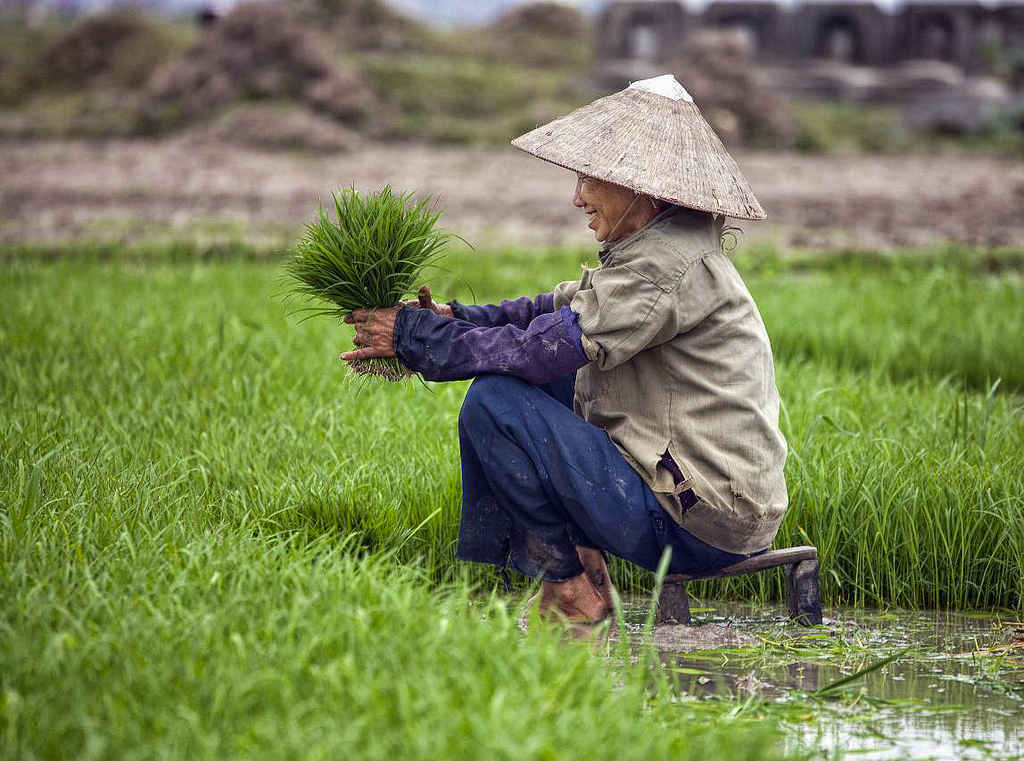Like many nations, Vietnam’s growth prospects are challenged by conflicting objectives. The ruling Communist Party aims to reach high-income status by 2045, which would improve wellbeing indicators. But the Party has also committed to various environmental targets. In light of Vietnam’s susceptibility to climate change, it should prioritise ‘green growth’ — ensuring that the economy’s natural assets can support the wellbeing of future generations.
Over the past three decades, Vietnam has used its competitive advantages in agriculture and cheap labour to increase its exports at an average rate of 12 per cent each year. But the longevity of this export-led growth is doubtful. Decreasing rice yields and lower fishery catches suggest that Vietnam’s production levels, encouraged by export demand, are depleting its natural resources.
Farmers in the Mekong Delta have sought to increase rice production with high-yielding seeds and chemical fertilisers. This intensive cultivation has degraded soil quality, which is feared to reduce overall soil fertility and crop yields over time. To prevent unsustainable internal developments from stifling future growth, the Ministry of Agriculture and Rural Development has supported System of Rice Intensification methods aimed at increasing rice yields while reducing costs and water usage. Recent studies indicate that greater coordination between farmers and the government — as well as increased training — is required for its implementation.
The disruptive potential of new technologies poses an additional challenge to Vietnam’s export-led growth. Increasingly sophisticated automation could eliminate Vietnam’s competitive advantage in labour-intensive manufacturing and see factories move elsewhere. Existing growth strategies may neither lift living standards nor protect the environment.
While rapid growth in Vietnam’s agricultural and manufacturing sectors has raised living standards, this has been coupled with a dramatic rise in energy demand by producers and consumers. Greenhouse gas emissions more than quadrupled from 2000 to 2015 and this trend is expected to continue. As a result of Vietnam’s economic growth ambitions, over half of its population may have joined the global middle class by 2035. This is projected to drive growth in electricity demand by 6–7 per cent per year as consumers demand digital technologies and other energy-intensive goods.
Significant proportions of Vietnam’s ‘energy mix’ are harmful non-renewable sources like coal (49.7 per cent), oil (21.7 per cent) and gas (5.9 per cent). The continued use of non-renewables is concerning due to the impact of climate change on the country. Vietnam is one of the countries most severely affected by climate change. Vietnam’s poorest — many of whom live along the Mekong Delta in areas that frequently flood — will be disproportionately affected.
Environmental degradation — partially caused by unsustainable growth practices — will increase sea and air pollution, with a range of social and health consequences. A 2017 study found that ‘air pollution was the sixth leading cause of death in Vietnam’ and a majority of Hanoian participants in another survey expressed that air pollution was more concerning than job security. These consequences have negative flow-on effects on the economy. Increased rates of illness and death place a higher burden on the health system and government finances while also reducing productivity.
Several key challenges impact Vietnam’s ability to transition to sustainable practices, many of which result from the country’s institutional design and leadership.
The feasibility of a green growth strategy is largely dependent on whether policymakers can ‘get the prices right’ and correct market failures. Vietnam’s current carbon pricing instruments, embodied in the Environmental Protection Tax, are ‘lower than most countries and too low to incentivise large-scale decarbonisation’. To galvanise structural change, a combination of higher taxes and subsidies that encourage the use of — and investment into — renewable energy sources is needed.
Green growth is limited by the institutional capacity to invest in and adopt greener technologies. The prevalence of state-owned enterprises in industrial sectors —and their resource allocation inefficiencies— limits this potential. Greater private sector participation is seen as a path to increasing productivity levels and green growth’s feasibility. Private firms, especially foreign ones, are better placed to access and adopt greener technologies. The Vietnamese government may need to commit to expanding private sector participation and growth in the domestic market.
The Vietnamese government’s directives and planning are currently causing coordination failures that are limiting progress. This is seen in the conflicting and overlapping environmental goals between Vietnam’s 2050 National Climate Change Strategy and its 2021-30 Green Growth Strategy. Coordination failures are also seen in the Mekong Delta area, where ‘planning and implementation roles are spread across several ministries, agencies, and provinces’.
Even if institutional coordination is improved, corruption remains a concern. The acceptance of bribes and irregular payments to evade environmental regulations limits the effectiveness of environmental measures.
Despite the considerable benefits that green growth could deliver for Vietnam, its feasibility is highly compromised. While the challenges are not insoluble, they require significant changes to the government’s institutional design and ethos.
Addressing these issues will likely generate additional problems. Transitioning to sustainable growth will trigger structural change, necessitating labour market safety nets to retrain displaced workers — many of whom may be poor and unskilled. Growth rates may also suffer, reducing Vietnam’s ability to reach its 2045 high-income goal. Despite this, action must be taken to advance green growth and avoid the long-term economic, social and health consequences of unsustainable growth.
Source : East Asia Forum


